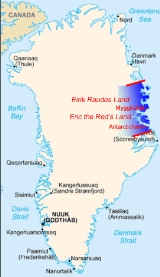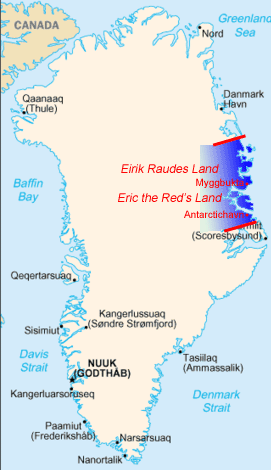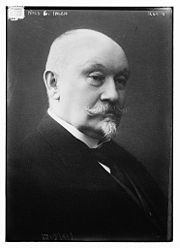
Ihlen Declaration
Encyclopedia

Norway
Norway , officially the Kingdom of Norway, is a Nordic unitary constitutional monarchy whose territory comprises the western portion of the Scandinavian Peninsula, Jan Mayen, and the Arctic archipelago of Svalbard and Bouvet Island. Norway has a total area of and a population of about 4.9 million...
Foreign Minister, Nils Claus Ihlen
Nils Claus Ihlen
Nils Claus Ihlen was a Norwegian engineer and politician for the Liberal Party. He served as foreign minister of Norway between 1913 and 1920.-Personal life:...
, on the topic of Denmark
Denmark
Denmark is a Scandinavian country in Northern Europe. The countries of Denmark and Greenland, as well as the Faroe Islands, constitute the Kingdom of Denmark . It is the southernmost of the Nordic countries, southwest of Sweden and south of Norway, and bordered to the south by Germany. Denmark...
's sovereignty
Sovereignty
Sovereignty is the quality of having supreme, independent authority over a geographic area, such as a territory. It can be found in a power to rule and make law that rests on a political fact for which no purely legal explanation can be provided...
over Greenland
Greenland
Greenland is an autonomous country within the Kingdom of Denmark, located between the Arctic and Atlantic Oceans, east of the Canadian Arctic Archipelago. Though physiographically a part of the continent of North America, Greenland has been politically and culturally associated with Europe for...
, which Mr. Ihlen declared verbally to the Danish Minister that "...the plans of the Royal [Danish] Government respecting Danish sovereignty over the whole of Greenland...would be met with no difficulties on the part of Norway." The declaration became an issue when the question was raised whether or not the statement was binding on Norway
Norway
Norway , officially the Kingdom of Norway, is a Nordic unitary constitutional monarchy whose territory comprises the western portion of the Scandinavian Peninsula, Jan Mayen, and the Arctic archipelago of Svalbard and Bouvet Island. Norway has a total area of and a population of about 4.9 million...
. The question eventually went all the way to the Permanent Court of International Justice
Permanent Court of International Justice
The Permanent Court of International Justice, often called the World Court, was an international court attached to the League of Nations. Created in 1922 , the Court was initially met with a good reaction from states and academics alike, with many cases submitted to it for its first decade of...
in the form of the Eastern Greenland Case in 1933.
The declaration

Spitsbergen
Spitsbergen is the largest and only permanently populated island of the Svalbard archipelago in Norway. Constituting the western-most bulk of the archipelago, it borders the Arctic Ocean, the Norwegian Sea and the Greenland Sea...
which Norway might submit at an upcoming peace conference, if Norway would not oppose the Danish claim at the same conference to the whole of Greenland
Greenland
Greenland is an autonomous country within the Kingdom of Denmark, located between the Arctic and Atlantic Oceans, east of the Canadian Arctic Archipelago. Though physiographically a part of the continent of North America, Greenland has been politically and culturally associated with Europe for...
. This was on 4 July 1919. At the time, Norway occupied certain parts of East Greenland.
In response, Ihlen made the declaration on 22 July 1919 that "...the plans of the Royal [Danish] Government respecting Danish sovereignty over the whole of Greenland...would be met with no difficulties on the part of Norway."
Eastern Greenland Case
However, Norway continued to occupy East Greenland into the 1930s. This led Denmark and Norway to agree to take the case to the Permanent Court of International JusticePermanent Court of International Justice
The Permanent Court of International Justice, often called the World Court, was an international court attached to the League of Nations. Created in 1922 , the Court was initially met with a good reaction from states and academics alike, with many cases submitted to it for its first decade of...
in 1933. This led the to several questions, Are affirmations made by one government to another binding? Was the declaration valid if it was made in violation of Norwegian municipal law article 46 - invalidity (article 27 - observance) of the Norwegian Constitution requiring consent by the Norwegian Parliament to enter into a treaty? Should Denmark have known that assent by the Norwegian Parliament was needed to make a treaty?
The International Court at the Hague awarded the disputed territory to Denmark. The Court declared that the Ihlen declaration constituted an unconditional and definitive promise. The decision was accepted by both countries.

